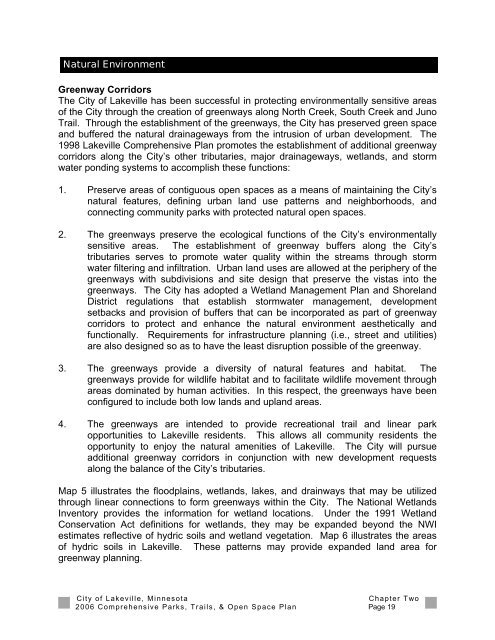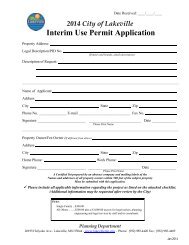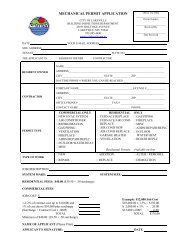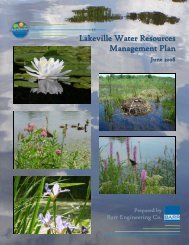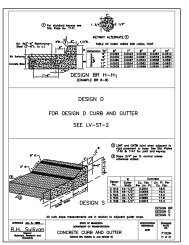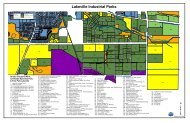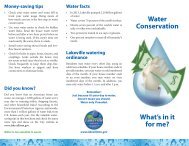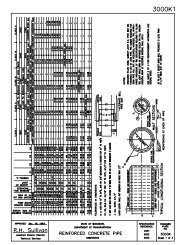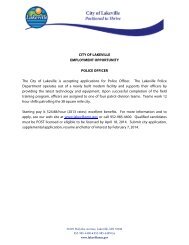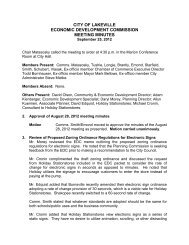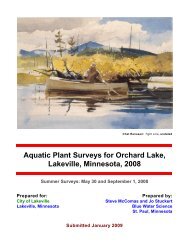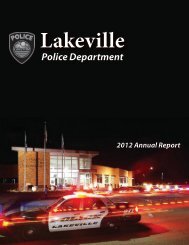2006 Parks, Trails and Open Space Plan - City of Lakeville
2006 Parks, Trails and Open Space Plan - City of Lakeville
2006 Parks, Trails and Open Space Plan - City of Lakeville
You also want an ePaper? Increase the reach of your titles
YUMPU automatically turns print PDFs into web optimized ePapers that Google loves.
Natural Environment<br />
Greenway Corridors<br />
The <strong>City</strong> <strong>of</strong> <strong>Lakeville</strong> has been successful in protecting environmentally sensitive areas<br />
<strong>of</strong> the <strong>City</strong> through the creation <strong>of</strong> greenways along North Creek, South Creek <strong>and</strong> Juno<br />
Trail. Through the establishment <strong>of</strong> the greenways, the <strong>City</strong> has preserved green space<br />
<strong>and</strong> buffered the natural drainageways from the intrusion <strong>of</strong> urban development. The<br />
1998 <strong>Lakeville</strong> Comprehensive <strong>Plan</strong> promotes the establishment <strong>of</strong> additional greenway<br />
corridors along the <strong>City</strong>’s other tributaries, major drainageways, wetl<strong>and</strong>s, <strong>and</strong> storm<br />
water ponding systems to accomplish these functions:<br />
1. Preserve areas <strong>of</strong> contiguous open spaces as a means <strong>of</strong> maintaining the <strong>City</strong>’s<br />
natural features, defining urban l<strong>and</strong> use patterns <strong>and</strong> neighborhoods, <strong>and</strong><br />
connecting community parks with protected natural open spaces.<br />
2. The greenways preserve the ecological functions <strong>of</strong> the <strong>City</strong>’s environmentally<br />
sensitive areas. The establishment <strong>of</strong> greenway buffers along the <strong>City</strong>’s<br />
tributaries serves to promote water quality within the streams through storm<br />
water filtering <strong>and</strong> infiltration. Urban l<strong>and</strong> uses are allowed at the periphery <strong>of</strong> the<br />
greenways with subdivisions <strong>and</strong> site design that preserve the vistas into the<br />
greenways. The <strong>City</strong> has adopted a Wetl<strong>and</strong> Management <strong>Plan</strong> <strong>and</strong> Shorel<strong>and</strong><br />
District regulations that establish stormwater management, development<br />
setbacks <strong>and</strong> provision <strong>of</strong> buffers that can be incorporated as part <strong>of</strong> greenway<br />
corridors to protect <strong>and</strong> enhance the natural environment aesthetically <strong>and</strong><br />
functionally. Requirements for infrastructure planning (i.e., street <strong>and</strong> utilities)<br />
are also designed so as to have the least disruption possible <strong>of</strong> the greenway.<br />
3. The greenways provide a diversity <strong>of</strong> natural features <strong>and</strong> habitat. The<br />
greenways provide for wildlife habitat <strong>and</strong> to facilitate wildlife movement through<br />
areas dominated by human activities. In this respect, the greenways have been<br />
configured to include both low l<strong>and</strong>s <strong>and</strong> upl<strong>and</strong> areas.<br />
4. The greenways are intended to provide recreational trail <strong>and</strong> linear park<br />
opportunities to <strong>Lakeville</strong> residents. This allows all community residents the<br />
opportunity to enjoy the natural amenities <strong>of</strong> <strong>Lakeville</strong>. The <strong>City</strong> will pursue<br />
additional greenway corridors in conjunction with new development requests<br />
along the balance <strong>of</strong> the <strong>City</strong>’s tributaries.<br />
Map 5 illustrates the floodplains, wetl<strong>and</strong>s, lakes, <strong>and</strong> drainways that may be utilized<br />
through linear connections to form greenways within the <strong>City</strong>. The National Wetl<strong>and</strong>s<br />
Inventory provides the information for wetl<strong>and</strong> locations. Under the 1991 Wetl<strong>and</strong><br />
Conservation Act definitions for wetl<strong>and</strong>s, they may be exp<strong>and</strong>ed beyond the NWI<br />
estimates reflective <strong>of</strong> hydric soils <strong>and</strong> wetl<strong>and</strong> vegetation. Map 6 illustrates the areas<br />
<strong>of</strong> hydric soils in <strong>Lakeville</strong>. These patterns may provide exp<strong>and</strong>ed l<strong>and</strong> area for<br />
greenway planning.<br />
<strong>City</strong> <strong>of</strong> <strong>Lakeville</strong>, Minnesota<br />
Chapter Two<br />
<strong>2006</strong> Comprehensive <strong>Parks</strong>, <strong>Trails</strong>, & <strong>Open</strong> <strong>Space</strong> <strong>Plan</strong> Page 19


